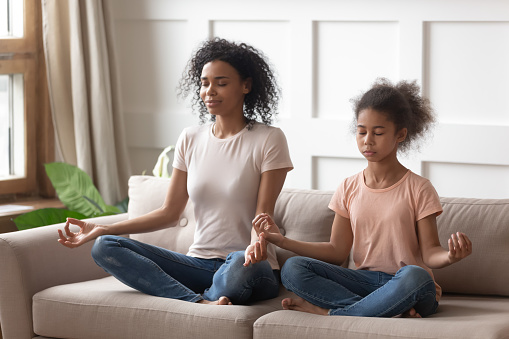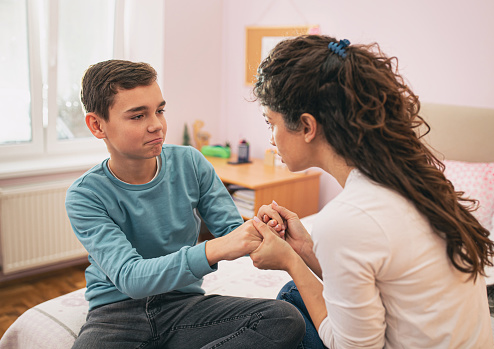In today’s fast-paced and stressful world, anxiety has become a common concern for children. Anxiety can affect a child’s overall well-being, including their physical and mental health. Relaxation techniques have become increasingly popular as a means of managing anxiety in children. These techniques are designed to help children cope with their anxiety by teaching them to relax their minds and body.
Relaxation techniques are a set of practices that can help individuals reduce stress, anxiety, and tension. These techniques can be used to promote a sense of calmness and relaxation in the body and mind. They can include activities such as deep breathing exercises, progressive muscle relaxation, yoga, mindfulness meditation, visualization, and sensory activities. The goal of these techniques is to shift the focus of attention away from stressful thoughts and feelings towards a state of relaxation and calm. Relaxation techniques can be practiced at any age and can be a valuable tool in promoting calmness and reducing stress. In this article, we will explore the benefits of relaxation techniques for children with anxiety and provide tips for parents on how to teach and incorporate these techniques into their child’s daily routine.
Types of relaxation techniques
I. Progressive Muscle Relaxation
One effective relaxation technique for kids with anxiety is Progressive Muscle Relaxation (PMR). PMR involves tensing and releasing different muscle groups throughout the body to help release physical tension and promote relaxation. This technique can be especially helpful for kids who may not yet have the vocabulary to express their emotions verbally. By engaging in PMR, children can learn to recognize and release tension in their bodies, which can help to reduce anxiety and stress levels. Practicing PMR regularly can also help children develop a greater sense of body awareness and encourage a more relaxed state of mind.
II. Deep breathing exercises
Deep breathing exercises are an effective relaxation technique for children coping with anxiety. These exercises encourage children to take slow, deep breaths, filling their lungs with oxygen and calming their nervous system. By practicing deep breathing exercises, children can regulate their breathing, which helps to reduce feelings of anxiety and stress. Parents can teach their children how to perform deep breathing exercises by instructing them to inhale slowly through their nose for four counts, hold their breath for two counts, and exhale slowly through their mouth for six counts. With consistent practice, deep breathing exercises can become a habit for children, making it easier for them to manage their anxiety.

III. Visualization
Visualization is a relaxation technique that involves creating mental images to promote relaxation and calmness. To practice visualization, guide your child to imagine a peaceful scene or place, such as a beach or a forest. Encourage them to use all their senses to make the image more vivid and realistic. This technique can be used to reduce anxiety, improve concentration, and promote positive thinking. Visualization is a simple yet powerful relaxation technique that can be practiced anywhere, anytime. By helping your child visualize a peaceful setting, you can help them create a sense of inner calm and relaxation, which can help them manage their anxiety and improve their overall well-being.
IV. Yoga
Yoga is a powerful relaxation technique that can be beneficial for children with anxiety. Through the practice of various poses and breathing exercises, yoga helps children to quiet their minds and relax their bodies. By focusing on the present moment and being mindful of their breath and movements, children can develop a sense of calm and inner peace. The physical benefits of yoga, such as increased flexibility and strength, can help to reduce tension and promote relaxation. With regular practice, yoga can become a valuable tool for children to manage their anxiety and promote overall well-being.

Benefits of relaxation techniques
- Reduces stress hormones: Relaxation techniques help lower cortisol levels, a hormone associated with stress, and promote the release of endorphins, which increase feelings of calm and well-being.
- Enhances emotional regulation: Relaxation techniques teach kids how to manage their emotions better, including anxiety, fear, and anger. They learn to identify their feelings and use relaxation techniques to help them feel more in control.
- Improves sleep: Relaxation techniques help kids fall asleep faster and improve the quality of their sleep. This can be especially helpful for kids who struggle with insomnia due to anxiety.
- Increases self-awareness: Relaxation techniques promote mindfulness, which is the practice of paying attention to the present moment. This helps kids become more aware of their thoughts, feelings, and physical sensations, and develop a better understanding of themselves.
- Enhances focus and concentration: Relaxation techniques can help kids calm their minds and focus on the task at hand. This can be particularly helpful for kids who have trouble with attention and focus due to anxiety.
- Reduces physical symptoms of anxiety: Relaxation techniques can help reduce physical symptoms of anxiety such as muscle tension, headaches, and stomach aches.
- Promotes overall well-being: Relaxation techniques can improve a child’s overall sense of well-being, reducing stress and promoting a more positive outlook on life.
- Helps kids cope with challenging situations: Relaxation techniques provide kids with a toolbox of coping strategies that they can use to manage anxiety and stress in challenging situations, such as tests, public speaking, or social events.

How to teach relaxation techniques to children
Teaching relaxation techniques to children can be a valuable tool for managing anxiety and stress. Here are some ways to effectively teach relaxation techniques to children:
A. Age-appropriate techniques: When teaching relaxation techniques to children, it is essential to choose techniques that are appropriate for their age and developmental level. For younger children, simple techniques such as deep breathing or visualization may be more effective, while older children may benefit from mindfulness meditation or progressive muscle relaxation exercises.
B. Creating a calming environment: It is important to create a calming and comfortable environment when teaching relaxation techniques to children. Find a quiet space free of distractions, and create a relaxing atmosphere by dimming the lights, playing soft music, or using essential oils.
C. Modeling relaxation techniques: Children learn best through modeling, so it is important to model relaxation techniques for them. Practicing the techniques yourself and showing your child how to do them can help them understand the process better. You can also use guided relaxation exercises or relaxation apps to help guide them through the techniques.
D. Practice and consistency: Like any new skill, learning relaxation techniques takes practice and consistency. Encourage your child to practice the techniques daily, and make it a regular part of their routine. Set aside specific times during the day to practice, such as before bedtime or during homework time. Be patient and persistent, and celebrate small successes along the way.

Other ways to support a child with anxiety
A. Open Communication: One of the most crucial ways to support a child with anxiety is by keeping open communication. Parents should encourage their children to express their feelings, concerns, and fears. It is essential to listen to them and validate their emotions. Parents should also make sure that their children feel comfortable discussing their anxiety symptoms with them. By creating a safe and supportive environment, parents can help their children build resilience against anxiety. Additionally, when children are taught relaxation techniques, they can be encouraged to share how they feel before and after doing them to help parents understand which ones work best for them.
B. Encouragement and Positive Reinforcement: Parents can help their children build self-confidence and self-esteem by providing them with encouragement and positive reinforcement. It is important to acknowledge and praise their efforts and progress, no matter how small. By doing this, parents can help their children feel more secure and confident in their abilities to manage their anxiety. When children practice relaxation techniques, parents can provide positive feedback and reinforcement to encourage them to continue using them.
C. Professional Support: If a child’s anxiety is severe, parents should seek professional support. A therapist can help the child learn coping strategies and teach them relaxation techniques that are tailored to their specific needs. A therapist can also help parents learn how to support their children in managing their anxiety. Additionally, a therapist can help identify any underlying issues that may be contributing to the child’s anxiety.
D. Lifestyle Changes: Lifestyle changes can be beneficial in managing anxiety in children. Parents can encourage their children to engage in physical activities that promote relaxation and stress relief, such as yoga or mindfulness exercises. Parents should also ensure their children are getting enough sleep and eating a healthy diet. Reducing screen time and encouraging outdoor activities can also be helpful in managing anxiety. These changes can complement the use of relaxation techniques and promote a more balanced and relaxed lifestyle.
Conclusion
In conclusion, helping children cope with anxiety is a complex and multifaceted process that requires patience, persistence, and a holistic approach. While relaxation techniques such as progressive muscle relaxation, deep breathing exercises, and mindfulness meditation can be effective in managing anxiety, it is important to also consider other ways to support children such as open communication, positive reinforcement, seeking professional support and lifestyle changes. By creating a safe and supportive environment, encouraging positive behaviors, and seeking professional help when necessary, parents can help their children build resilience and develop effective strategies for managing their anxiety. Ultimately, the goal is to help children feel empowered and confident in their ability to manage their emotions and lead fulfilling lives.

